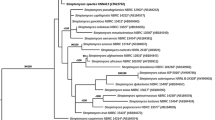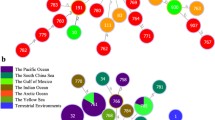Abstract
This study was designed to determine the biogeography of six alkaliphilic Streptomyces strains which had been isolated from four locations within a 60 m transect across a beach and dune sand system. The six strains shared >99% 16S rRNA gene similarities with one another and with representative strains of Streptomyces griseus. Infraspecific diversity amongst the strains was investigated by multilocus sequence typing (MLST) in combination with carbon utilisation phenotypic testing. The results show that each of the strains is genotypically and phenotypically distinct. Furthermore, the MLST and carbon utilisation profiles were congruent thereby providing preliminary evidence which suggests that the observed infraspecific diversity is consistent with ecological selection. The results also demonstrate that infraspecific diversity can be observed over small spatial scales. These findings support the hypothesis that the six isolates are ecovars of Streptomyces griseus. The implications of these findings for prokaryotic biogeography and bioprospecting are discussed.



Similar content being viewed by others
References
Antony-Babu S, Goodfellow M (2008) Biosystematics of alkaliphilic streptomycetes isolated from seven locations across a beach and dune sand system. Antonie Van Leeuwenhoek (submitted)
Bentley SD, Chater KF, Cerdeno-Tarraga AM, Challis GL, Thomson NR, James KD, Harris DE, Quail MA, Kieser H, Harper D and 33 other authors (2002) Complete genome sequence of the model actinomycete Streptomyces coelicolor A3(2). Nature 417:141–147
Bérdy J (2005) Bioactive microbial metabolites. J Antibiot 58:1–26
Breslauer KJ, Frank R, Blöcher H, Marky LA (1986) Predicting DNA duplex stability from the base sequence. Proc Natl Acad Sci 83:3746–3750
Bruntner C, Binder T, Pathom-aree W, Goodfellow M, Bull AT, Potterat O, Puder C, Schmid A, Bolek W (2005) Frigocyclonine, a novel angucyclinone antibiotic produced by a Streptomyces griseus strain from Antarctica. J Antibiot 58:346–349
Bull AT, Ward AC, Goodfellow M (2000) Search and discovery strategies for biotechnology: the paradigm shift. Microbiol Mol Rev 64:573–606
Chenna R, Sugawara H, Koike T, Lopez R, Gibson TJ, Higgins DG, Thompson JD (2003) Multiple sequence alignment with the CLUSTAL series of programs. Nucleic Acids Res 31:3497–3500
Cho JC, Tiedje JM (2000) Biogeography and degree of endemicity of fluorescent Pseudomonas strains in soil. Appl Environ Microbiol 66:5448–5456
Chun J (1995) Computer-assisted classification and identification of actinomycetes. Department of Agriculture and Environmental Sciences, University of Newcastle, Newcastle-upon-Tyne
Coenye T, Gevers D, Van de Peer Y, Vandamme P, Swings J (2005) Towards a prokaryotic genomic taxonomy. FEMS Microbiol Rev 29:147–167
Cohan FM (2002) What are bacterial species? Annu Rev Microbiol 56:457–487
Eck RV, Dayhoff MO (1966) Atlas of protein sequence and structure. National Biomedical Research Foundation, Silver Springs
Fenchel T (2003) Biogeography for bacteria. Science 301:925–926
Fenchel T, Esteban GF, Finlay BJ (1997) Local versus global diversity of microorganisms: cryptic diversity of ciliated protozoa. Oikos 80:220–225
Fiedler HP, Bruntner C, Bull AT, Ward AC, Goodfellow M, Potterat O, Puder C, Mihm G (2005) Marine actinomycetes as a source of novel secondary metabolites. Antonie Van Leeuwenhoek 87:37–42
Findlay BJ (2002) Global dispersal of free-living microbial eukaryote species. Science 296:1061–1063
Fox GE, Wisotzkey JD, Jurtshuk P Jr (1992) How close is close: 16S rRNA sequence identity may not be sufficient to guarantee species identity. Int J Syst Evol Microbiol 42:166–170
Gevers D, Cohan FM, Lawrence JG, Spratt BG, Coenye T, Fell EJ, Stackebrandt E, Van de Peer Y, Vandamme P, Thompson FL (2005) Re-evaluating prokaryotic species. Nat Rev Microbiol 3:733–739
Goodfellow M, Manfio GP, Chun J (1997) Towards a practical species concept for cultivable bacteria. In: Claridge MF, Dawah HA, Wilson MR (eds) Species: the units of biodiversity. Chapman & Hall, London, pp 25–59
Goodfellow M, Kumar Y, Labeda DP, Sembiring L (2007) The Streptomyces violaceusniger clade: a home for streptomycetes with rugose ornamented spores. Antonie Van Leeuwenhoek 92:173–199
Graf E, Schneider K, Nicholson G, Ströbele M, Jones AL, Goodfellow M, Beil W, Süssmuth D, Fiedler H-P (2007) Elloxazinones A and B, new aminophenoxazinones from Streptomyces griseus ACTA 2871. J Antibiot 60:277–284
Guo Y, Zheng W, Rong X, Huang Y (2008) A multilocus phylogeny of the Streptomyces griseus 16S rRNA gene clade: use of multilocus sequence analysis for streptomycete systematics. Int J Syst Evol Microbiol 58:149–159
Hedlund BP, Staley JT (2004) Microbial endemism and biogeography. In: Bull AT (ed) Microbial diversity and bioprospecting. ASM Press, Washington, pp 225–231
Höltzel A, Dieter A, Schmid DG, Brown R, Goodfellow M, Beil W, Jung G, Fiedler HP (2003) Lactonamycin Z, an antibiotic and antitumor compound provided by Streptomyces sanglieri strain AK 623. J Antibiot 56:1058–1061
Ikeda H, Ishikawa J, Hanamoto A, Shinose M, Kikuchi H, Shiba T, Sakaki Y, Hattori M, Ōmura S (2003) Complete genome sequence and comparative analysis of the industrial microorganism Streptomyces avermitilis. Nat Biotechnol 21:526–531
Jaccard P (1908) Adaptative hierarchical clustering schemes. Syst Zool 19:58–82
Jaspers E, Overmann J (2004) Ecological significance of microdiversity: identical 16S rRNA gene sequences can be found in bacteria with highly divergent genomes and ecophysiologies. Appl Environ Microbiol 70:4831–4839
Jensen PR, Mafnas C (2006) Biogeography of the marine actinomycete Salinispora. Environ Microbiol 8:1881–1888
Jensen PR, Mincer TJ, Williams PG, Fenical W (2005) Marine actinomycete diversity and natural product discovery. Antonie Van Leeuwenhoek 87:43–48
Jensen PR, Williams PG, Oh CD, Zeigler L, Fenical W (2007) Species specific secondary metabolite production in marine actinomycetes of the genus Salinispora. Appl Environ Microbiol 73:1146–1152
Kieser T, Bibb MJ, Buttner M, Chater KF, Hopwood DA (2000) Practical Streptomyces genetics. The John Innes Foundation Norwich, UK
Kim WY (2004) The Streptomyces violaceoruber clade: a model system for defining a post-genomic species concept for streptomycetes. School of Biology, University of Newcastle, Newcastle-upon-Tyne, UK
Kimura M (1980) A simple method for estimating evolutionary rates of base substitutions through comparative studies of nucleotide sequences. J Mol Evol 16:111–120
Koeppel A, Perry EB, Sikorski J, Krizanc D, Warner A, Ward DM, Rooney AP, Brambilla E, Connor N, Ratcliff RM, Nevo E, Cohan FM (2008) Identifying the fundamental units of bacterial diversity: a paradigm shift to incorporate ecology into bacterial systematics. Proc Natl Acad Sci USA 105:2504–2509
Korber B (2000) HIV signature and sequence variation analysis. Computational analysis of HIV molecular sequences. In: Rodrigo AG, Learn GH (eds) Computational and evolutionary analysis of HIV molecular sequences. Kluwer Academic Publishers, Boston, pp 55–72
Korn F, Weingärtner B, Kutzner HJ (1978) A study of actinophages: morphology, serological relationship and host range. In: Freerksen I, Tárnok I, Thumim JH (eds) Genetics of the Actinomycetales. Gustav Fischer Verlag, Stuttgart, pp 251–270
Kumar Y, Aiemsum-ang P, Ward AC, Goodfellow M (2007) Diversity and geographical distribution of members of the Streptomyces violaceusniger 16S rRNA gene clade detected by clade-specific PCR primers. FEMS Microbiol Ecol 62:54–63
Larsen TO, Smedsgaard KF, Nielsen KF, Hansen ME, Frisvad JC (2005) Phenotypic taxonomy and metabolite profiling in microbial drug discovery. Nat Prod Rep 22:672–675
Majewski J, Cohan FM (1999) Adapt globally, act locally: the effect of selective sweeps on bacterial sequence diversity. Genetics 152:1459–1474
Martens M, Dawyndt P, Coopman R, Gillis M, De Vos P, Willems A (2008) Advantages of multilocus sequence analysis for taxonomic studies: a case study using 10 housekeeping genes in the genus Ensifer (including former Sinorhizobium). Int J Syst Evol Microbiol 58:200–214
Martiny JBH, Bohannan BJM, Brown JH, Colwell RK, Fuhrman JA, Green JL, Horner-Devine MC, Kane M, Krumins JA, Kuske CR, Morin PJ, Naeem S, Øvreås L, Reysenbach AL, Smith VH (2006) Microbial biogeography: putting microorganisms on the map. Nat Rev Microbiol 4:102–112
Palys T, Nakamura LK, Cohan FM (1997) Discovery and classification of ecological diversity in the bacterial world: the role of DNA sequence data. Int J Syst Evol Microbiol 47:1145–1156
Papke RT, Ramsing NB, Bateson MM, Ward DM (2003) Geographical isolation in hot spring cyanobacteria. Environ Microbiol 5:650–659
Pathom-aree W, Stach JEM, Ward AC, Horikoshi K, Bull AT, Goodfellow M (2006) Diversity of actinomycetes isolated from Challenger Deep sediment (10,898 m) from the Mariana Trench. Extremophiles 10:181–189
Piel J (2004) Metabolites from symbiotic bacteria. Nat Prod Rep 21:519–538
Rainey PB, Travisano M (1998) Adaptive radiation in a heterogeneous environment. Nature 394:69–72
Ramette A, Tiedje JM (2007) Biogeography: an emerging cornerstone for understanding prokaryotic diversity, ecology, and evolution. Microbiol Ecol 5:197–207
Rohlf FJ (1988) NTSYS-pc: numerical taxonomy and multivariate analysis system, version 2.0, user guide. Exeter Software, New York
Rossellö-Mora R, Amann R (2001) The species concept for prokaryotes. FEMS Microbiol Rev 25:39–67
Saitou N, Imanashi T (1989) Relative efficiencies of the Fitch-Margoliash, maximum-parsimony, maximum-likehood, minimum-evolution, and neighbor-joining methods of phylogenetic tree construction in obtaining the correct tree. Mol Biol Evol 6:514–525
Saitou N, Nei M (1987) The neighbor-joining method: a new method for reconstructing phylogenetic trees. Mol Biol Evol 4:406–425
Sembiring L, Ward AC, Goodfellow M (2000) Selective isolation and characterisation of members of the Streptomyces violaceusniger clade associated with the roots of Paraserianthes falcataria. Antonie Van Leeuwenhoek 78:353–366
Sneath PHA, Sokal RR (eds) (1973) Numerical taxonomy: the principles and practice of numerical classification. W.H. Freeman and Co., San Francisco
Sokal RR, Michener CD (1958) A statistical method for evaluating systematic relationships. Kansas Univ Sci Bull 38:1409–1438
Stackebrandt E, Frederiksen W, Garrity GM, Grimont PAD, Kämpfer P, Maiden MCJ, Nesme X, Rosselló-Mora R, Swings J, Trüper HG, Vauterin L, Ward AC, Whitman WB (2002) Report of the ad hoc committee for the re-evaluation of the species definition in bacteriology. Int J Syst Evol Microbiol 52:1043–1047
Staley JT, Gosink JJ (1999) Poles apart: biodiversity and biogeography of sea ice bacteria. Annu Rev Microbiol 53:189–215
Strohl W (2004) Antimicrobials. In: Bull AT (ed) Microbial diversity and bioprospecting. ASM Press, Washington, pp 288–313
Thompson FL, Gevers D, Thompson CC, Davyndt P, Naser S, Hoste B, Munn CB, Swings F (2005) Phylogeny and molecular identification on the basis of multilocus sequence analysis. Appl Environ Microbiol 71:5107–5115
Tamura K, Dudley J, Nei M, Kumar S (2007) MEGA4: molecular evolutionary genetics analysis (MEGA) software version 4.0. Mol Biol Evol 24:1596–1599
Venter JC, Remington K, Heidelberg JF, Halpern AL, Rusch D, Eisen JA, Wu D, Paulsen I, Nelson KE, Nelson W (2004) Environmental genome shotgun sequencing of the Sargasso Sea. Science 304:66–74
Ward AC, Goodfellow M (2004) Phylogeny and functionality: taxonomy as a roadmap to genes. In: Bull AT (ed) Microbial diversity and bioprospecting. ASP Press, Washington, pp 288–313
Watve MG, Tickoo R, Jog MM, Bhole BD (2001) How many antibiotics are produced by the genus Streptomyces? Arch Microbiol 176:386–390
Whitaker RJ (2006) Allopatric origins of microbial species. Philos Trans Roy Soc B 361:1975–1984
Whitaker RJ, Grogan DW, Taylor JW (2003) Geographic barriers isolate endemic populations of hyperthermophilic archaea. Science 301:976–978
Wiens JJ, Donoghue MJ (2004) Historical biogeography, ecology and species richness. Trends Ecol Evol 19:639–644
Acknowledgements
Sanjay Antony-Babu is grateful to the University of Newcastle for the award of an International Research Scholarship and to the School of Biology for a Research Studentship.
Author information
Authors and Affiliations
Corresponding author
Rights and permissions
About this article
Cite this article
Antony-Babu, S., Stach, J.E.M. & Goodfellow, M. Genetic and phenotypic evidence for Streptomyces griseus ecovars isolated from a beach and dune sand system. Antonie van Leeuwenhoek 94, 63–74 (2008). https://doi.org/10.1007/s10482-008-9246-y
Received:
Accepted:
Published:
Issue Date:
DOI: https://doi.org/10.1007/s10482-008-9246-y




